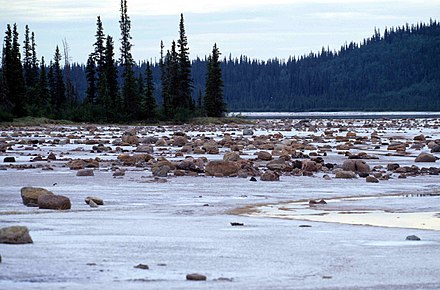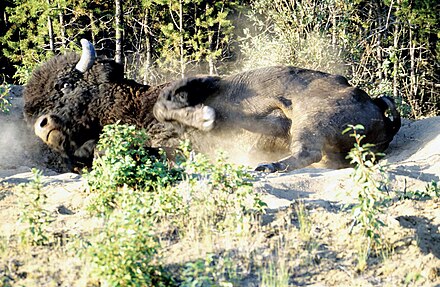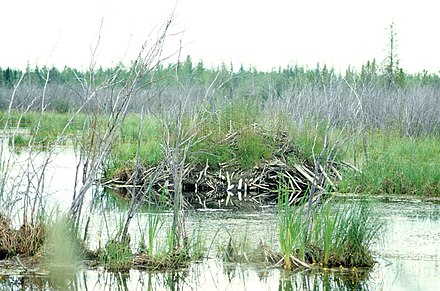Wood Buffalo National Park - national park in Canada
Wood Buffalo National Park is a vast, protected wilderness in northeastern Alberta and the southern Northwest Territories. The park has been designated a UNESCO World Heritage Site due to its bison population (the largest in North America) and the largest inland delta.
Understand


Wood Buffalo National Park is the largest national park of Canada at 44,807 km² (17,300 sq mi), It is in northeastern Alberta and the southern Northwest Territories. Larger in area than Switzerland, it is the second-largest national park in the world. The park was established in 1922 to protect the world's largest herd of free roaming wood bison, estimated at more than 5,000. It is one of two known nesting sites of whooping cranes.
The park completely surrounds several Indian reserves such as Peace Point and ?Ejere K'elni Kue (also called Hay Camp).
This area was designated a UNESCO World Heritage Site in 1983 for the biological diversity of the Peace-Athabasca Delta, one of the world's largest freshwater deltas, as well as the population of wild bison.
In 2013, the Royal Astronomical Society of Canada designated Wood Buffalo National Park as the world's largest dark-sky preserve. Parks Canada claims that the designation will help preserve nighttime ecology for the park’s large populations of bats, night hawks and owls, as well as providing opportunities for visitors to experience the northern lights.
Contact the Fort Smith main office and visitor centre +1 867 872-7960 (24 hr hotline +1 867 872-7962), or the Fort Chipewyan satellite office +1 780-697-3662. Email: wbnp.info@pc.gc.ca . Visitor services are open M-F 9AM-noon, 1PM-5PM, and closed on statutory holidays.
History
This region has been inhabited by human cultures since the end of the last ice age. Aboriginal peoples in this region have followed variations on the subarctic lifeway, based around hunting, fishing, and gathering. Situated at the junction of three major rivers used as canoe routes for trade — the Athabasca, Peace and the Slave Rivers — the region that later became the national park was well travelled for millennia.
In recorded times, the Dane-zaa (historically called the "Beaver tribe"), the Chipewyan people, the South Slavey (Dene Tha'), and Woods Cree people are known to have inhabited, and sometimes quarrelled over, the region. The Dane-zaa, Chipewyan, and South Slavey speak (or spoke) languages from the Northern Athabaskan family which is also common in the regions to the north and west of the park, and call themselves the "Dene" collectively. The Cree, by contrast, are an Algonquian people and are thought to have migrated here from the east within the timeframe of recorded history.
Sometime after 1781 when a smallpox epidemic decimated the region, the two groups made a peace treaty at Peace Point through a ceremonial pipe ceremony. This is the origin of the name of the Peace River which flows through the region: the river became the boundary with the Dane-zaa to the north and the Cree to the south.
Explorer Peter Pond is believed to have passed through the region in 1785, likely the first European to do so, followed by Alexander Mackenzie three years later. In 1788 fur trading posts were established at Fort Chipewyan just east of the current boundaries of the park and Fort Vermilion just to the west. And the Peace River, which had long been used by the First Nations as a trade route, also now also added to the growing network of canoe routes used in the North American fur trade. From the fur trade, the Métis people emerged as another major group in the region.
Canada purchased the Hudson's Bay Company's claim to the region in 1896. Agriculture was never developed in this part of Western Canada, unlike to the south; thus hunting and trapping remained the dominant industry in this region well into the 20th century, and are still vital to many of its inhabitants. Following the Klondike Gold Rush of 1897, however, the Canadian governments was keen to extinguish Aboriginal title to the land, so that any mineral wealth found in the future could be exploited despite any objections from First Nations. This led to the signing of Treaty 8 on 21 June 1899. The land then passed into the hand of the federal government as "Crown land".
Established in 1922, the park was created on Crown land acquired the territory of Treaty 8 between Canada and the local First Nations.
Between 1925 and 1928, over 6,000 plains bison were introduced to the park, where they hybridized with the local wood bison, and introduced bovine tuberculosis and brucellosis diseases into the herd. Parks officials have since that time attempted to undo this damage with successive culls of diseased animals. In 1957, however, a disease-free, wood bison herd of 200 was discovered near Nyarling river in Wood Buffalo National Park. In 1965, 23 of these bison were relocated to the south side of Elk Island National Park and 300 remain there today as the most genetically pure wood bison remaining. Between 1951 and 1967, four thousand bison were killed and 2,000,000 pounds (910,000 kg) of meat were sold from a special abattoir built at Hay Camp. These smaller culls did not eradicate the diseases, however, and in 1990 a plan was announced to cull the entire herd and restock it with undiseased animals from Elk Island National Park. This plan was abandoned due to a negative public reaction to the announcement. Since that time, wolves, the bison's main predator, have recovered in numbers due to a reduction in control efforts (mostly poisoning), reducing the size of the herd.
Landscape
The park ranges in elevation from 183 m (600 ft) at the Little Buffalo River to 945 m (3,100 ft) in the Caribou Mountains. The park contains one of the world's largest fresh water deltas, the Peace-Athabasca Delta, formed by the Peace, Athabasca and Birch Rivers. It is also known for its karst sinkholes in the north-eastern section of the park. Alberta's largest springs (by volume, with an estimated discharge rate of eight cubic meters per second), Neon Lake Springs, are in the Jackfish River drainage. Wood Buffalo is directly north of the Athabasca Oil Sands.
Fauna
 Wood Buffalo National Park contains a large variety of wildlife species, such as moose, bison, great grey owls, black bears, hawks, spotted owls, wolf packs, lynxes, beavers, snowy owls, marmots, bald eagles, martens, wolverines, peregrine falcons, whooping cranes, snowshoe hares, sandhill cranes, ruffed grouses, and the world's northernmost population of red-sided garter snakes, which form communal dens within the park.
Wood Buffalo National Park contains a large variety of wildlife species, such as moose, bison, great grey owls, black bears, hawks, spotted owls, wolf packs, lynxes, beavers, snowy owls, marmots, bald eagles, martens, wolverines, peregrine falcons, whooping cranes, snowshoe hares, sandhill cranes, ruffed grouses, and the world's northernmost population of red-sided garter snakes, which form communal dens within the park.
Wood Buffalo Park contains the only natural nesting habitat for the endangered whooping crane. Known as Whooping Crane Summer Range, it is classified as a Ramsar site. It was identified through the International Biological Program. The range is a complex of contiguous water bodies, primarily lakes and various wetlands, such as marshes and bogs, but also includes streams and ponds.
In 2007, the world's largest beaver dam – about 850-m (2,790 ft) in length – was discovered in the park using satellite imagery. The dam, located at 58°16.3′N 112°15.1′W, about 200 km (120 mi) from Fort Chipewyan, had only been sighted by satellite and fixed-wing aircraft until July 2014.
Climate
Temperatures can vary from -50 °C in the winter to 30 °C in the summer. Average seasonal highs are winter:-20 °C, spring:-1 °C, summer:17 °C, fall:8 °C.
Towns & villages
There are no towns located within Wood Buffalo National Park
- Fort Chipewyan (Alberta) – located on the shores of Lake Athabasca; accessible by air and seasonal ice roads
- Fort Smith (Northwest Territories) – located just north of the Alberta/Northwest Territories border
Prepare
- Bug spray, lots of blackflies and huge mosquitoes.
- Bring any food and potable water you intend to consume in the park; there are freshwater streams, but stream water must be boiled before use.
- Keep a full tank of fuel in your vehicle; fuel is available in Fort Smith village but you will often be travelling vast distances.
Get in
By car
- There is a road from Hay River through the park to Fort Smith, a three and a half hour journey. As of January 2019, the road into the park is now fully paved.
By plane
- Northwestern Air has 5 flights a week to Fort Smith from Edmonton
By boat
- The Slave River is navigable in summer from Fort Chip to Fort Smith, but obstructed further north by rapids. The Athabasca River continues further south through Fort McMurray. There is an ice road in winter but no all-season road. A portage at Fort Smith was part of the journey in the 1930s Yellowknife gold rush.
Fees and permits
For 2018:
- Fishing permit daily $9.80
Get around
Portions of the site are on or within hiking distance of roads. Access to more distant points is by small aircraft; once the outfitter drops you off, you're on your own until the plane returns - usually days later. Until then, it's just you and the bears enjoying nature together.
See
This is the world's only nesting site for the very endangered Whooping Crane and the last refuge of the now-recovering Wood Buffalo population.
It is also home to the world's largest beaver dam.
Do
- Hike through the Salt Plains, explore the Peace-Athabasca Delta and view wildlife
- Paddle a canoe or a boat
- Swim in a sinkhole
- Go fishing
- Bike the Park
- Join a scheduled tour (weekly, mid-June to end-August, $13.70/person, register at the Visitor's Centre at least 15 minutes before the 1PM departure time. Salt Plains Guided Tour on Tuesdays, Grosbeak Lake Guided Tour on Thursdays and Guided Canoe Tours at Pine Lake on Saturdays.
- Xplorers Program for kids (1PM every other Sunday, July-August, meet at Visitors’ Centre, no fees). Contact the park office for themes and location.
- Campfire programs
- View the aurora borealis on the bitterly cold, dark Arctic winter nights from the world's largest Dark Sky Preserve.
Buy
Eat
There are picnic grounds at these locations within the park:
- Angus Fire Tower and Day-use Area near the entrance to the park off Highway 5
- Salt Plains Viewpoint and Day-use Area. Access from Highway 5
- Salt River Day-use Area on Pine Lake Road.
- Rainbow Lakes Backcountry Campsite is a 6 km hike from Pine Lake Road,
Drink
Sleep
Lodging
- Kettle Point Group Camp, +1 867 872-7960. Eight-person minimum group, reservations required. Lakeside beach facility with large, cosy log shelter, outhouses, tenting area, playground, picnic tables, fire circle and firewood. per group $39.20 2018-01-26
Camping
- Primitive campsites are available at Pine Lake for $15.70/night (2018).
Backcountry
Overnight backcountry camping (as of 2018) is $9.80/person per night:
- Rainbow Lakes Backcountry Campsite is beside a beautiful sinkhole lake, a 6 km hike from Pine Lake Road. Tent pad, picnic table, outhouse and bear cache.
- Pine Lake Campground and Day-use Area, 59.534989°, -112.235341°. Kettle Point Group Camp, 60 km south of Fort Smith on Pine Lake Road.
Any fees for park entry, tours or programs are additional to the campsite prices.
Stay safe
Nearby
- Fort Smith, a town of 2500 people just across the Northwest Territories border provides various services to park visitors. There are restaurants, a few guest houses, a hotel and a Northern Store. Fort Smith Airport (IATA: YSM), the base of operations for Northwestern Air, provides flights to Edmonton, Fort Chipewyan, Hay River, High Level and Yellowknife.